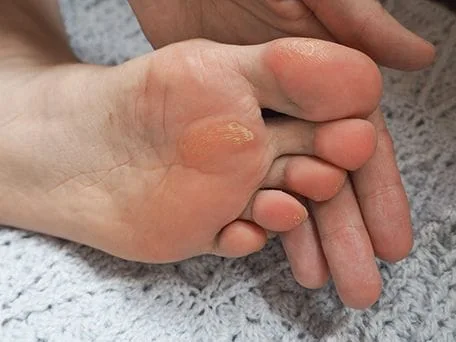
What are Corns and Calluses?
Corns and calluses are both caused due to the hardening of the skin on your feet. Corns, in particular, are smaller and commonly occur at the bottom, top, or between toes. They are of two types:
- soft corns—typically form between toes
- hard corns—dry corns that form on the top side of toes
Calluses are larger and appear on the soles of your feet—the heel and ball of the foot, or the outer side of the big toe.
Patients with diabetes or poor circulation should regularly check their feet and seek podiatric care to treat and manage their corns and calluses. If left untreated, they can turn into open sores and become more harmful.
What Are the Causes of Corns and Calluses?
Corns and calluses appear on your feet as a protective response. Repeated friction over from tight shoes or hard ground surfaces on the bone spurs of your toes or feet causes the skin to harden and prevent the formation of blisters or open sore.
While blisters occur on your feet over shorter periods from large amounts of friction, calluses and corns are the opposite. Regular amounts of pressure over a longer period of time lead to patients developing corns or calluses.
Some common causes of corns and calluses include:
- wearing high heels or tightly fitting shoes
- foot abnormalities
- hammertoes make you more predisposed to forming corns
What Are the Symptoms of Corns and Calluses?
Symptoms of corns and calluses include:
- pain
- difficulty walking
- discoloration inside the corn or callus due to bleeding
- hardened, dry skin
What to Expect During Treatment for Corns and Calluses at the Podiatrist
Taking proper care of your feet, along with regular daily foot inspections, is key to managing and preventing corns and calluses from developing. If you see a corn or callus developed, seek medical treatment from a podiatrist as over-the-counter treatment use harsh acids and can cause more harm than damage, especially if used repeatedly. This is key if you are a patient with diabetes or poor blood circulation, as an infection is more likely.
A proper foot exam by your podiatric physician will help determine how and why your corns and calluses exist. Improperly fitted shoes, foot abnormalities, or certain trauma can increase your chances of developing a callus or corn. Treatment depends on the severity of your corn and callus and can include:
- properly fitted shoes
- corn and callus cushions to prevent more friction
- special orthotic inserts
- cortisone injection to reduce pain and swelling
- trimming of corns and calluses, especially if painful
- x-rays of other imaging tests to determine if there's an underlying bone problem at the root of your corn or callus—especially if chronic
